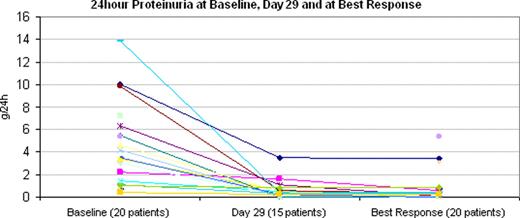Abstract
Abstract 5114
Light chain-induced renal failure (LC-ARF) is a severe complication of MM associated with increased risk of infections, dependency on chronic hemodialysis and shortened survival. Reversibility of renal impairment depends on the degree of renal damage, the duration of renal failure and the quality of response to anti-myeloma therapy. In this phase II trial we assess the efficacy of lenalidomide-dexamethasone in reducing pathogenic light chains and restoring renal function. In addition, we analyze the kinetics of treatment response in patients with LC-ARF.
Patients and Methods: 24 patients with LC-ARF as formerly defined (JCO 2010) have been enrolled so far. Age (median): 65.5 years (range: 46–78 years), Gender: male/female: 12/12. All patients presented with ISS stage III. 20 (83.3%) had de novo MM and 4 (16.7%) previously treated, but relapsing disease. Median GFR was 19.9 ml/min (range 6.1 – 37.2 ml/min). ECOG performance was 0 in 6, I-II in 14 and III-IV in 4 patients, respectively. One patient died before first study medication, 3 patients died within the first cycle and 2 patients dropped out early (< 2 cycles). Lenalidomide was given from d 1–21 with dose adaptation according to GFR. Dexamethasone 40 mg was administered on d 1–4, 9–12, 17–20 during cycle 1; thereafter 1x/week. Cycles were repeated q 4 weeks.
Presently, 17 patients are evaluable for response (completed ≥2 cycles and fully documented). The median number of cycles is 9 (range 2–9). CR was achieved in 5 (31.3%), nCR in 4 (25%), VGPR in 2 (12.5%) and PR in 5 (25%) patients, respectively, yielding an ORR (CR+nCR+VGPR+PR) of 94% for the evaluable and 69.6% for the ITT population. Median time to best tumor response was 132 days. The greatest proportional reduction in 24 hour urinary excretion (86%) in responding patients occurred within the first 4 weeks of therapy, with only little further improvement beyond that time (figure 1).
Renal response was assessed as formerly defined (JCO 2010). 3 patients achieved CRrenal, 3 PRrenal and 5 MRrenal, yielding an ORRrenal in 11 patients (64.7% of the evaluable and 47.8% of the ITT population). Median time to best renal response was 83 days. 3 of 10 dialysis dependent patients became dialysis independent.
Median GFR of evaluable patients increased from 15.2 (range 6.1 – 35.1 ml/min) at baseline to a median best GFR of 28.3 ml/min (range 11.3 – 101.1 ml/min) (p<0.0075). The greatest increase in median GFR was noted in the 5 patients with CR (26.7 to 60.9 ml/min, p<0.024) while in those with nCR/VGPR/PR a less pronounced improvement in GFR (10.6 to 22.4 ml/min, p<0.025) was observed
Tolerance: Full documentation of adverse events is presently available in 23 patients. Four patients died, 1 (4.3%) each due to infection and cardiac arrest and 2 (8.7%) with unknown causes of death (sudden death). Grade 3/4 anemia, thrombopenia and leucopenia, were seen in 11 (47.8%), 7 (30.4%), and 3 (13%) patients, respectively. Other common grade 3/4 toxicities were infection/sepsis in 9 (39.1%), and cardiac dysfunction in 5 (21.7%) patients, respectively. Exanthema and fatigue were seen in 2 patients (8.7%), and pulmonary embolism and macula edema in 1 patient each (4.3%).
LD showed significant anti-myeloma activity with an overall response rate of 94% in the evaluable and of 69.9% in the ITT population. The greatest proportional decrease in 24 hour proteinuria (86%) was obtained already within the first 4 weeks of therapy while renal recovery occurred with delay only. Improvement in renal function was obtained in 65% of the evaluable and in 48% of the ITT population. Toxicity of the LD regimen with the lenalidomide dose adjusted to GFR was as expected in this high risk population. Updated results will be presented.
Ludwig:Celgene: Research Funding, Speakers Bureau.
Author notes
Asterisk with author names denotes non-ASH members.


This feature is available to Subscribers Only
Sign In or Create an Account Close Modal